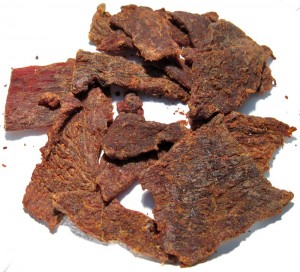I don’t know if this was real or just some rumor that circulated; but, in my youth I recall hearing a story about an unspecified type of jerky that was found in sealed containers at an American Indian archeological site in the desert of the four corners region. In other words, a perfect environment for keeping meat preserved; think mummies in Egypt. According to this “rumor” the jerky, while completely devoid of nutrients, was none the less still edible. How fantastic is that? I can’t substantiate this story and though I’ve tried I haven’t found any clues leading to a true or untrue story. This prompted me to read some Back to Basics (which I highly recommend you acquire), and doing a little additional research on the topic of jerky, with an after note on pemmican (which is not the same as jerky).
Some of the info listed below is a combination of personal knowledge and paraphrasing information out of books; other portions are direct quotes. The main book source is used was the 3rd Edition Readers Digest Back to Basics and the online sources are listed below. I’ve tried making the infamous oven dried jerky, but it always ended up getting eaten before it was done; I’m a sucker for a good teriyaki flavored meat product. There are some simple ways to make homemade smokehouses if you can’t afford an industrial one; the attached diagram is just to give you a simple idea. From National Geographic’s Ultimate Survival Alaska the advice was given that in the absence of accurate temperature gauges assume every day in the smokehouse will equal one week of shelf stable life.
Anyway, have fun.
Jon
History of Jerky
The modern English word jerky is in fact not an English word; it likely comes from “Ch’arki”, a name from the Quechuan language of the Incas and literally translates into “dried meat”; while others say it originates from the Spanish word “charque.”. It was a common sense discovery made out of necessity to make a kill from a hunt last without spoilage; especially with early nomadic peoples who needed food that could be carried with them; jerky was flavorful, compact, and almost all meat aside from pork could be made into the stuff. Some say American Indians made jerky first made modern style jerky thousands of years ago from buffalo; others believe it was the ancient Inca tribe called the Quechua that made jerky as early as the 1500’s. The first use of any form of jerky can be traced back to ancient Egypt. Humans in those ancient Egyptian times made jerky from animal meat that was too big to eat all at once, such as bear, buffalo, or whales. While this is what the experts say, I can’t help but look back at the smoked and dried fish that the peoples of my Danish born land have made as long as people have lived there, and not believe that most peoples from the origins of fire and roasting meat; learned the basic concepts of this art. Either way, the traditional jerky we’ve come to love in our day is likely a time tested recipe which has been passed from generation to generation. I suspect salting meat was more popular in later European years because it was a less labor intensive process and could be used with pork; but I don’t know.
According to historians when the first Europeans arrived in the New World they found the Natives making a meal product that did not have to be consumed immediately and instantly realized that value in this. Many of the tribes produced a product called “pemmican” which I will explain later, as it is different that plain jerked meat. The Americans taught the settlers how to cut the meat into this strips, season the meat, and then smoke it. Early settlers ate a lot of this meat as a consistent part of their diets. For the Europeans and expansionists, jerky reaching its peak in popularity during the westward expansion into North America. This was also the time when many other meats were introduced as standard form of jerky like turkey, goose, and other wild game.
What is Jerky?
If you didn’t know, Jerky is a “nutrient-dense meat that has been made lightweight by drying.” Typically a pound of meat or poultry weighs about four ounces after being made into jerky. It becomes shelf stable (storable without refrigeration) because most of the moisture is removed, making it a handy food for backpackers and others who don’t have access to refrigerators; as stated above.
Food Safety and Jerky
Pathogenic bacteria could survive and cause food-borne illness when raw meat or poultry is improperly dehydrated.
How Can Drying Make it Safe?
Drying is the world’s oldest and most common method of food preservation. Canning technology is less than 200 years old and freezing became practical only during this century when electricity became more and more available to people. Drying technology is both simple and readily available to most of the world’s culture. The scientific principal of preserving food by drying is that by removing moisture, enzymes cannot efficiently contact or react with the food. Whether these enzymes are bacterial, fungal, or naturally occurring autolytic enzymes from the raw food, preventing this enzymatic action preserves the food from biological action.
Why is Temperature Important When Making Jerky?
Illnesses due to Salmonella and E. coli O157:H7 from homemade jerky raise questions about the safety of traditional drying methods for making beef and venison jerky. Heat the meat to 160o F before the dehydrating process. This step assures that any bacteria present will be destroyed by wet heat. But most dehydrator instructions do not include this step, and a dehydrator may not reach temperatures high enough to heat meat to 160o F. If your dehydrator can’t reach 160o F, heat the meat in an oven first. After heating to 160o F, maintaining a constant dehydrator temperature of 130 to 140o F during the drying process is important because the process must be fast enough to dry food before it spoils; and it must remove enough water that microorganisms are unable to grow.
Expectations For Shelf Life
Beef jerky lasts for 1-2 Years
Turkey jerky lasts for 1-2 Years
Homemade jerky lasts for 2-3 Months
How to tell if beef jerky is bad, rotten or spoiled?
It is the color and texture of the jerky that will change, it will become darker and harder. The smell will also be slightly different. Once these changes happen, the taste is also off and not recommended. The leaner the meat, the longer it will keep because it is the fat that starts to break down and go rancid first. Practicing proper hygiene and food safety discipline will help prevent food borne illness.
How to store beef jerky to extend its shelf life?
Commercially vacuum sealed packaging in a cool dark place like the pantry, away from the stove or other appliances and sunlight, is always going to be the most effective way to store jerky. For even longer storage, you can freeze your beef, turkey or pork jerky until ready to use. Proper food storage is the key to extending the expiration date of food.
Pemmican
Pemmican is a concentrated mixture of fat and protein used as a nutritious food. The word comes from the Cree word pimîhkân, which itself is derived from the word pimî, “fat, grease”. It was invented by the native peoples of North America. It was widely adopted as a high-energy food by Europeans involved in the fur trade and later by Arctic and Antarctic explorers, such as Robert Falcon Scott and Roald Amundsen.
Traditionally, pemmican was prepared from whatever meat was available, usually the lean meat of large game such as buffalo, elk or deer. The meat was cut in thin slices and dried over a slow fire, or in the hot sun until it was hard and brittle. About five pounds of meat are required to make one pound of dried meat suitable for pemmican. Then it was pounded into very small pieces, almost powder-like in consistency, using stones. The pounded meat was mixed with melted fat in an approximate 1:1 ratio. In some cases, dried fruits such as saskatoon berries, cranberries, blueberries, or choke cherries were pounded into powder and then added to the meat/fat mixture, but almost exclusively in ceremonial and wedding pemmican. The resulting mixture was then packed into rawhide pouches for storage.
Key Online References:
http://en.wikipedia.org/wiki/Pemmican
http://www.jerky.com/history-of-jerky
http://www.uidaho.edu/extension/twinfalls/jerkyhowto



Leave a Reply